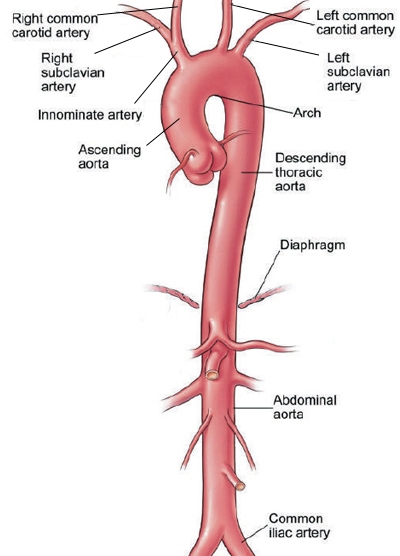This week we turn our attention to a problem outside the heart—aortic aneurysms. An aneurysm is a focal enlargement or bulging of a blood vessel. It comes from the Greek word meaning “dilation.” In fact, radiology reports will often use the term “dilated” to refer to a vessel that is larger than normal, but not large enough or focal enough to use the term “aneurysm.” However, this is a subtle distinction and this blog will consider any abnormal enlargement of an artery to be aneurysmal (the adjective for something that has an aneurysm).
The aorta is the large artery into which the left ventricle pumps blood across the aortic valve and is the conduit for blood flowing throughout the body. It is divided into the thoracic and the abdominal aorta, with the abdominal aortal being that part of the aorta below the diaphragm—the dividing structure between the thorax (chest) and abdomen. The thoracic aorta is further sub-divided into the ascending aorta (the part that rises upward from the heart toward the neck and head), the aortic arch (the part that becomes more horizontal and—as the name implies—archlike), and the descending aorta (the part that travels downward through the chest toward the diaphragm). An image of the aorta is shown below.

Any part of the aorta can become aneurysmal. What makes enlargement dangerous is based on an equation you might remember from high school physics: Laplace’s Law. The tension on the wall of a tube (like an artery) is proportional to both the pressure within the tube—in an artery, that would be the blood pressure—and the diameter. So, as the artery gets larger (the diameter increases), the tension goes up, putting more stress on the arterial wall and increasing the risk of rupturing.
When an aortic aneurysm ruptures, it doesn’t exactly explode (though that is the term non-physicians often use), but develops a rip or tear. Sometimes the tear is small and surrounding tissues can contain the blood—we call this a leaking aneurysm or a contained rupture. But, if the tear is large and there is no surrounding tissue to push against the outward force of the blood, then a person has had a true rupture and will bleed very rapidly through the opening, generally dying within a minute or two. So, aortic aneurysms are potentially quite dangerous!
The normal ascending aorta is no more than 3.5 cm in diameter. After the aortic arch, the descending aorta tapers to about 2.5 cm. The normal abdominal aorta is 2.0 cm. These numbers are averages and vary by age and body size. The risk of rupturing gradually rises as the aorta grows in size. The risk is quite low for a small aneurysm. However, when the aorta becomes larger than 5.5 cm, repair is generally recommended. The exact size that a particular person should have surgery, though, depends on several factors, including age, the disease that leads to the aneurysm, and co-morbid conditions (medical problems that can increase the risk of surgery).
In next week’s blog, we’ll discuss how we find aneurysms and how we manage them.
Greg Koshkarian, MD, FACC
